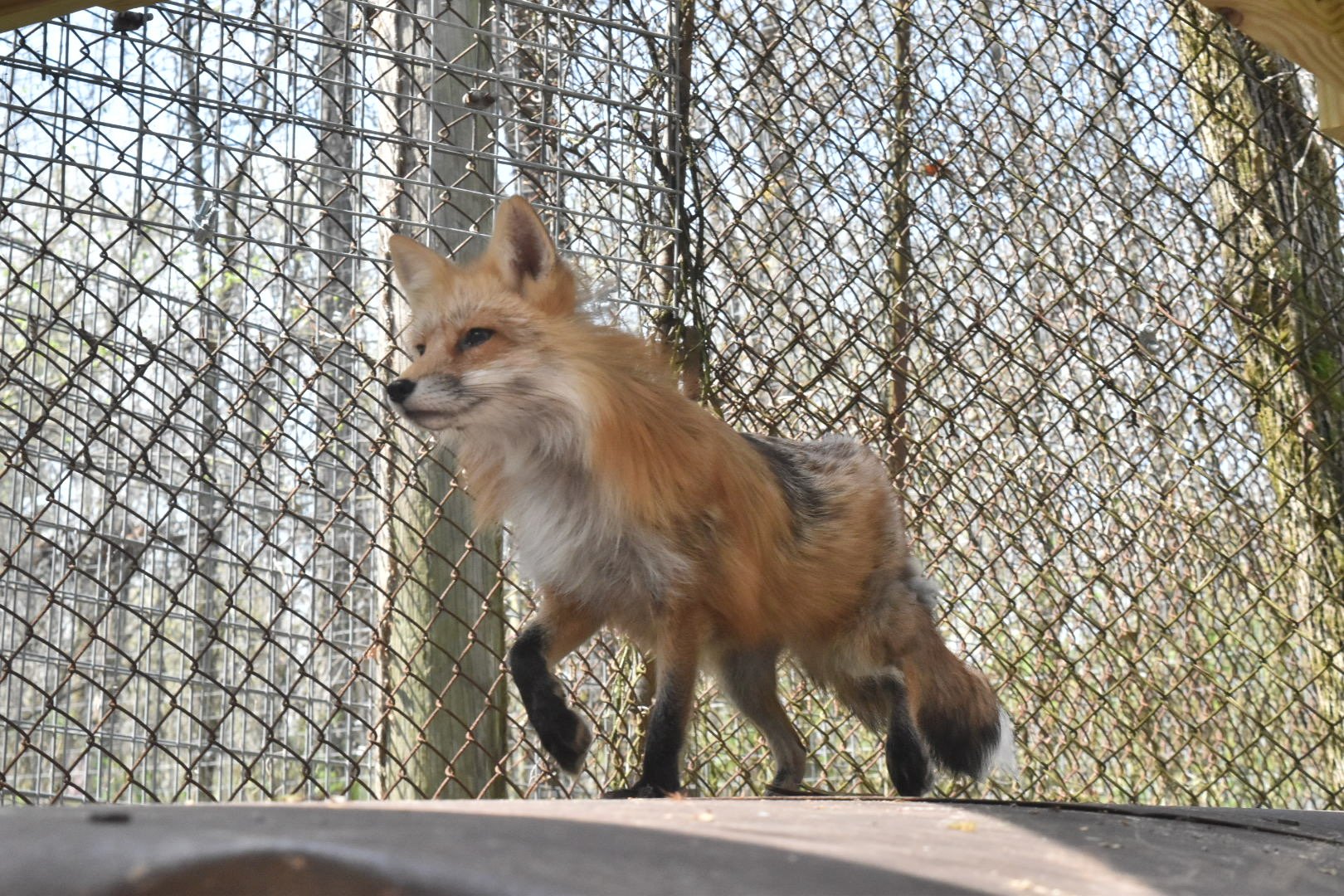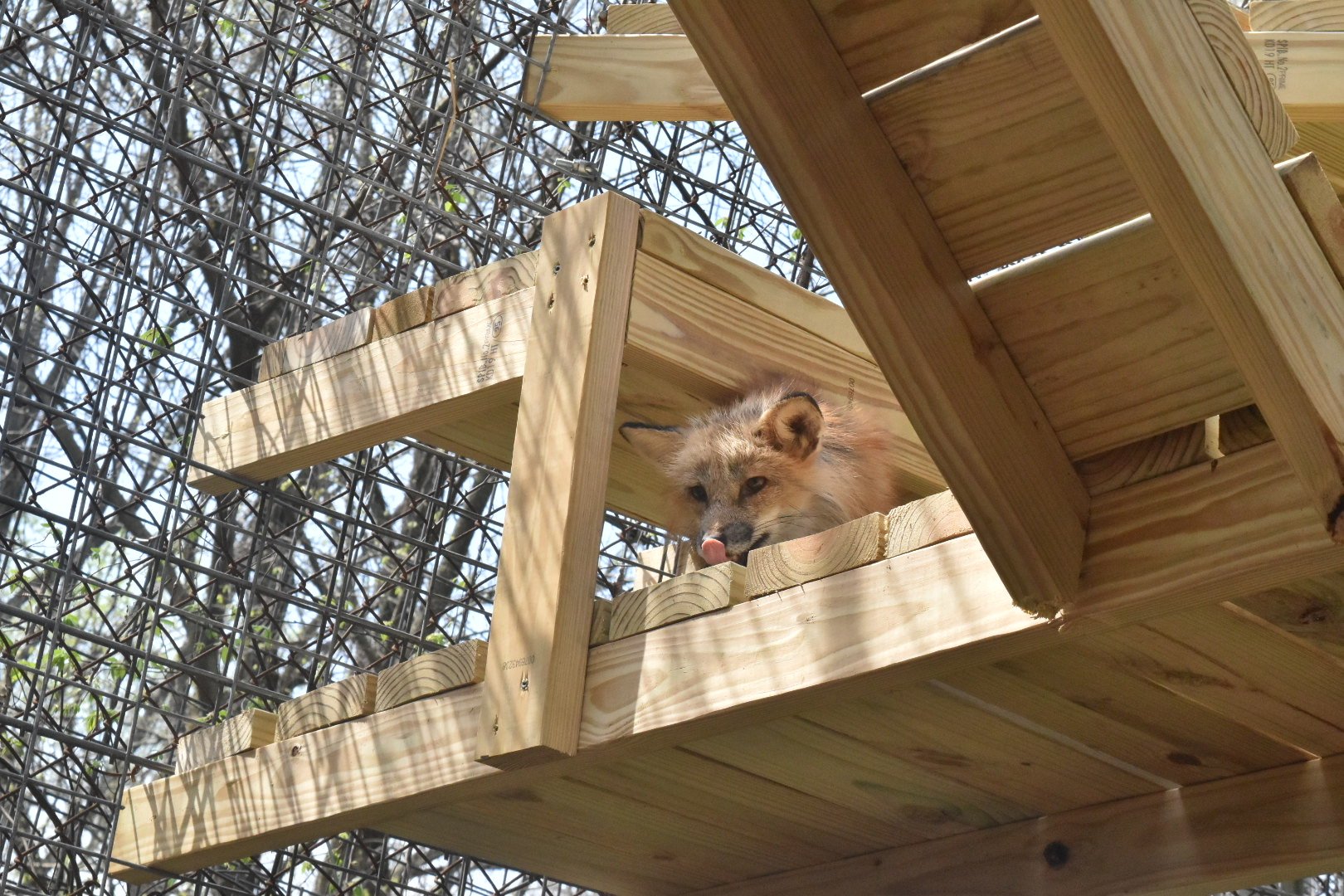*Content Warning, this is a developing story with some graphic photos attached. Proceed with that in mind*
Inside of the barn where some of the 400 animals were kept. Urine cans are seen under the cages.
In early February, we were alerted to a dire and urgent situation in Ashtabula County, Ohio, by Tigers in America. Tigers in America’s foundation has helped in the placement and welfare of many captively held tigers and other animals across the US and they’re a great partner in our rescue mission. The situation involved nearly 400 animals found in appalling conditions, requiring immediate intervention. Animals involved included coyotes, foxes, raccoons, hybrid wolf dogs, boars, and skunks. We collaborated with the USDA to identify potential homes for as many animals as possible and planned to bring supplies such as food, straw for bedding and crates for shelter. We knew we wouldn’t be able to take all of the animals, but we would take in what we could and help the rest. The USDA informed us that The Humane Society of the United States (HSUS) was given charge of the situation and recognizing the urgency of the situation, several organizations, rescues, sanctuaries, and rehabilitators joined forces to rehome over 330 animals. HSUS called the EFRC and we committed to taking in two coyotes and three foxes.
Upon arrival, even after over 30 years of rescue work, nothing could have prepared us for the conditions encountered at this site. The animals were confined to small, open wire cages that collected their waste, but did not provide any shelter from the elements. They had no access to food or water since the wind chill reached nearly 20 degrees below zero and the little food provided was too large to fit through the food shoots. Tragically, the extreme conditions had already claimed the lives of many animals by the time help arrived and several had to be humanely euthanized.
The site in Ohio was multifaceted in the way it treated these animals as just parts of the business and not living individuals. The animals were being raised and slaughtered for fur, bred for sale as exotic pets, and held captive for urine farming. Some of the animals had missing toes, ears, tails and limbs. Veterinarians determined that animals likely lost toes due to the cages’ wire flooring, while the animals missing limbs and paws had likely been caught in steel-jaw leghold traps found around the property. Piles of pelts were found stacked in the elements amongst barrels, traps, and wood.
Our head keeper, Rebecca, was deeply affected by the scene, stating, "In 20 years of working in rescue, I have never seen anything this horrifying and I will never be able to unsee the things I saw."
The HSUS requested our assistance with transporting animals to their new homes. Understanding the critical nature of the task, we loaded up foxes and wolfdogs to take to their destinations at other rescues. As we were loading foxes and coyotes to come home to the EFRC, we were asked if we could make the 6 1/2 hour drive again the next day to transport more. It was imperative that all the animals be relocated by Saturday to avoid euthanasia of any remaining animals. As we were preparing to transport the last of the wolfdogs, HSUS informed us of another issue: three wolfdogs still required placement. We immediately agreed to take them in until permanent homes could be found.
Upon returning to Indiana, we introduced the rescued foxes—named Delta, Blue, and Echo—to one another, and the mutual support they provided has been beneficial in their recovery. During their veterinary evaluations, we discovered that Delta, the female, is missing part of a front leg. Dr. Froderman believes this is likely the result of an old injury rather than a congenital defect. Additionally, while they were being spayed and neutered, we encountered an alarming case of ear mites in Echo, whose ears were so infested that the mites were visible without the use of an endoscope or a slide. The coyotes, named Cruise and Reggie, were introduced to two of our resident coyotes and are now enjoying their companionship and their well deserved freedom.
Since their arrival, the animals in our care have begun to enjoy a new lease on life, with proper diets and a clean, safe environment with stable, flat ground. This rescue operation, though borne of tragedy, has given these animals a chance at a better life and underscored the importance of our mission of ongoing vigilance and compassion in animal welfare efforts.










UPDATE AS OF APRIL 2025!
*Content Warning, this is a developing story with some graphic photos attached. Proceed with that in mind*
In April of 2025, we got an update on the situation involving nearly 400 animals found in appalling conditions, requiring immediate intervention. The animals were confined to small, open wire floored cages. Sadly, the terrible living conditions had claimed the lives of many of the animals and also caused many injuries to the ones remaining. In the end, over 330 animals needed to be rehomed. Initially, HSUS called the EFRC and we committed to taking in two coyotes and three foxes and temporarily housing other animals.
In the beginning of April, we were asked to take over the care of more of the Ohio rescues. Within one weekend, the EFRC took over care of more than 70 of the animals from the shut down Ohio fur and urine farm in Ashtabula County. They are being temporarily housed in our new clinic building until we can get them treated and moved to enclosures outside.
We noticed a significant amount of the foxes have mange and other skin issues that we started treatment for immediately. Some of the foxes had considerably worse medical conditions, including one fox with an open fracture. Our surgeons have already been able to come out and set the fracture with a plate and screws, adding a couple thousand dollars to the cost of taking in these animals.
We have always prided ourselves on providing amazing vet care to the animals who come to the rescue in rough shape and these Ohio rescues deserve the best. If you’d like to help towards the care of these animals, please consider donating any little bit towards the future care of these 70 animals we now have under our care. You can also support their care by picking up any of our merchandise items from our online gift shop or buying a “For Fox Sake” T-shirt/sticker or more from our specialty store!
We're committed to providing them the best care, but we need your support! We have already spent over $7000 on medical and construction costs for these 70+ new animals. Please consider donating whatever you can. Every contribution helps ensure these animals get the second chance they deserve. Thank you for your compassion and support!
-April 20th Updates
The first groups of the 70+ foxes are leaving the clinic. After being treated for mange and getting flea and tick treatments, they will be moved into new enclosures as soon as they are completed. The first group to move out is being lovingly referred to as “Toffee’s Team”. They are actually available to view on our main tour path! The group consists of Kristofferson (Toffee), Agnes, Hazel, and Ginger-all named by one of our keepers, Phoebe. They’re all very chill and seem to be loving the fresh air!
Agnes
Ginger
Kristofferson (Toffee)
Hazel
Meet Clover!
**GRAPHIC PHOTO WARNING**
Clover, a small female red fox, came the first weekend of April with an open fracture on her front left leg. The weekend she arrived was also our dental weekend. With the help of the Peter Emily Foundation dentists and University of Illinois Vet Med staff, we were able to set her up with a temporary cast to help stabilize the leg.
A couple days later, she had surgery to add hardware to her leg and it was casted again. Every 3-5 days involved checking her wounds, changing her cast, and trying to make sure this little fox kept her leg. On April 19th, we decided to try some different medication for her to help with the healing. We had many conversations with our vets that she may still need to have it amputated even after all this work.
As time went on, a few weeks after her initial surgery, around April 23rd it looked like Clover’s stitches were starting to hold a lot better. We were hopeful she would get to keep her leg! May 2nd Clover got another cast check and another xray, showing more promise. Progression photos are shown below.
We are happy to announce that she is now cast free. 🎉 Clover will be on restricted movement for the foreseeable future as we access her movement and make sure she is fully healed before we go to the next stage.
Clover's care alone has cost us over $5000 since we took her in on April 6th. Every bit has helped, even if you just leave a kind comment and a like or share, it all helps us help these amazing animals.
Photos of her without her cast on incoming




































